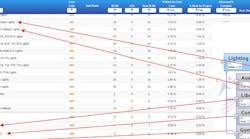Although virtually all workers in the electrical industry realize the potential dangers of electricity, and safety records at many companies continue to improve, alarming statistics still exist, such as those recently reported by the Electrical Safety Foundation International (ESFI), Rosslyn, Va.
-
One worker is killed each day due to electrical hazards.
-
Electrical hazards rank 6th among all causes of workplace fatalities.
-
Each year, 133 workplace deaths occur from contact with power lines.
-
Electrical hazards cause an average of 13 days away from work.
-
While not the leading cause of workplace deaths, electrical accidents are disproportionately fatal when they do occur.
To help maximize employee safety and combat these numbers, the Occupational Safety and Health Administration (OSHA), Washington, D.C., has updated the decades-old general-industry electrical installation standard found in Subpart S of 29 CFR Part 1910.
According to OSHA, “The agency has determined that electrical hazards in the workplace pose a significant risk of injury or death to employees, and that the requirements in the revised standard, which draw heavily from the 2000 edition of the National Fire Protection Association's (NFPA) Electrical Safety Requirements for Employee Workplaces (NFPA 70E), and the 2002 edition of the National Electrical Code (NFPA 70), are reasonably necessary to provide protection from these hazards.”
The final rule also replaces the reference to the 1971 NEC in the mandatory appendix to the powered platform standard with a reference to OSHA's electrical installation standard. This revision, which goes into effect on August 13, 2007, represents the first update of the installation requirements in the general-industry electrical installation standard since 1981.
The updated standard includes a new alternative method for classifying and installing equipment in Class I hazardous locations; new requirements for ground-fault circuit interrupters (GFCIs); and new provisions on wiring for carnivals and similar installations.
“The revised standard strengthens employee protections and adds consistency between OSHA's requirements and many state and local building codes, which have adopted updated NFPA and NEC provisions,” says Edwin G. Foulke Jr., OSHA's assistant secretary.
To view the new rule in its entirety, visit www.osha.gov/pls/oshaweb/owadisp.show_document?p_table=FEDERAL_REGISTER&p_id=19269.


